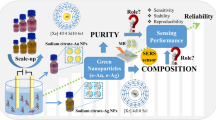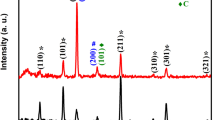Abstract
Surface-enhanced Raman scattering (SERS) technique is a powerful spectrum analysis technique for the ultra-low molecular trace detection. Conventionally, noble metals like silver (Ag) and gold (Au) are used to prepare the SERS substrates; however, limitations of complicated experimental designs and sophisticated process steps impede their wide applications in practice. Recently, metal oxides arise as a promising material for SERS application, but relatively weak Raman signal enhancement and poor material stability still pose as a challenge. Here, a UV-light-assisted fabrication of MoO3−x/silver nanoparticles (MoO3−x/Ag NPs) film is proposed. In the experiment, the sub-transition-metal-oxide of MoO3−x was used as the Raman chemical enhancement substrate as well as the reducing agent. Through the spin-coating of MoO3−x layer on the silicon substrate and UV-light-assisted reduction of silver nitride (AgNO3) on the MoO3−x layer, a novel MoO3−x/Ag NPs one-layer film was fabricated. Using the Rhodamine B (RhB) as the Raman reporter, SERS measurement shows that enhancement factor (EF) of 1.195 × 106 could be achieved. Moreover, a Raman signal amplifying strategy is further demonstrated by constructing MoO3−x/Ag NPs multi-layer films. And result evidences that maximum gain of 2.07 for the RhB Raman peak at 1280 cm−1 can be obtained on the MoO3−x/Ag NPs three-layer film when referred to that on the MoO3−x/Ag NPs one-layer film. Meanwhile, the EF of the MoO3−x/Ag NPs three-layer film is also improved to 2.985 × 106, giving the minimum detectable concentration of 10−9 M.








Similar content being viewed by others
References
Ding S-Y, Yi J, Li J-F, Ren B, Wu D-Y, Panneerselvam R, Tian Z-Q (2016) Nanostructure-based plasmon-enhanced raman spectroscopy for surface analysis of materials. Nat Rev Mate 1:16021-1–16021-16
Laing S, Jamieson LE, Faulds K, Graham D (2017) Surface-enhanced Raman spectroscopy for in-vivo biosensing. Nat. Rev. Chem. 1:0060-1–0060-19
Li J-F, Zhang Y-J, Ding S-Y, Panneerselvam R, Tian Z-Q (2017) Core-shell nanoparticle-enhanced Raman spectroscopy. Chem Rev 117:5002–5069
Reguera J, Langer J, Jiménez de Aberasturi D, Liz-Marzán LM (2017) Anisotropic metal nanoparticles for surface enhanced Raman scattering. Chem Soc Rev 46:3866–3885
Niu W, Chua YAA, Zhang W, Huang H, Lu X (2015) Highly symmetric gold nanostars: crystallographic control and surface-enhanced Raman scattering property. J Am Chem Soc 137:10460–10463
Liu K, Bai Y, Zhang L et al (2016) Porous Au–Ag nanospheres with high-density and highly accessible hotspots for SERS analysis. Nano Lett 16:3675–3681
Ye S, Benz F, Wheeler MC et al (2016) One-step fabrication of hollow-channel gold nanoflowers with excellent catalytic performance and large single-particle SERS activity. Nanoscale 8:14932–14942
Zhu C, Meng G, Zheng P et al (2016) A hierarchically ordered array of silver-nanorod bundles for surface-enhanced Raman scattering detection of phenolic pollutants. Adv Mater 28:4871–4876
Tian Y, Liu H, Chen Y et al (2019) Seedless one-spot synthesis of 3D and 2D Ag Nanoflowers for multiple phase SERS-based molecule detection. Sens Actuators B: Chem 301:127142(1–13)
Ashley MJ, Bourgeois MR, Murthy RR et al (2018) Shape and size control of substrate-grown gold nanoparticles for surface-enhanced Raman spectroscopy detection of chemical analytes. J Phys Chem C 122:2307–2314
He S, Kyaw YME, Tan EKM et al (2018) Quantitative and label-free detection of protein kinase a activity based on surface-enhanced Raman spectroscopy with gold nanostars. Anal Chem 90:6071–6080
Xu J, Wu D, Li Y, Xu J, Gao Z, Song Y-Y (2018) Plasmon-triggered hot-spot excitation on SERS substrates for bacterial inactivation and in situ monitoring. ACS Appl Mater Interfaces 10:25219–25227
Zhu C, Du D, Eychmüller A, Lin Y (2015) Engineering ordered and nonordered porous noble metal nanostructures: synthesis, assembly, and their applications in electrochemistry. Chem Rev 115:8896–8943
Lv W, Gu C, Zeng S, Han J, Jiang T, Zhou J (2018) One-pot synthesis of multi-branch gold nanoparticles and investigation of their SERS performance. Biosensors 8:113(1–10)
Ma W, Fu P, Sun M, Xu L, Kuang H, Xu C (2017) Dual quantification of MicroRNAs and telomerase in living cells. J Am Chem Soc 139:11752–11759
Zhang J, Li X, Sun X, Li Y (2005) Surface enhanced Raman scattering effects of silver colloids with different shapes. J. Phys. Chem. B 109:12544–12548
Jiang T, Chen G, Tian X, Tang S, Zhou J, Feng Y, Chen H (2018) Construction of long narrow gaps in Ag nanoplates. J Am Chem Soc 140:15560–15563
Li H, Yang Q, Hou J, Li Y, Li M, Song Y (2018) Bioinspired micropatterned superhydrophilic Au-areoles for surface-enhanced Raman scattering (SERS) trace detection. Adv Funct Mater 28:1800448(1–7)
Liu Z (2017) One-step fabrication of crystalline metal nanostructures by direct nanoimprinting below melting temperatures. Nat Commun 8:14910(1–7)
Yin G, Bai S, Tu X et al (2019) Highly sensitive and stable SERS substrate fabricated by Co-sputtering and atomic layer deposition. Nanoscale Res Lett 14:168
Zhou S, Zhao M, Yang T-H, Xia Y (2019) Decahedral nanocrystals of noble metals: synthesis, characterization, and applications. Mater Today 22:108–131
Sun L, Yu Z, Lin M (2019) Synthesis of polyhedral gold nanostars as surface-enhanced raman spectroscopy substrates for measurement of thiram in peach juice. Analyst 144:4820–4825
Cao Y-Q, Qin K, Zhu L, Qian X, Zhang X-J, Wu D, Li A-D (2017) Atomic-layer-deposition assisted formation of wafer-scale double-layer metal nanoparticles with tunable nanogap for surface-enhanced Raman scattering. Sci. Rep 7:5161(7–8)
Matricardi C, Hanske C, Garcia-Pomar JL, Langer J, Mihi A, Liz-Marzán LM (2018) Gold nanoparticle plasmonic superlattices as surface-enhanced Raman spectroscopy substrates. ACS Nano 12:8531–8539
Zhou S, Li J, Gilroy KD et al (2016) Facile synthesis of silver nanocubes with sharp corners and edges in an aqueous solution. ACS Nano 10:9861–9870
Lin D, Wu Z, Li S et al (2017) Large-area au-nanoparticle-functionalized Si nanorod arrays for spatially uniform surface-enhanced Raman spectroscopy. ACS Nano 11:1478–1487
Chen H-C, Hsu T-C, Liu Y-C, Yang K-H (2014) Surfactant-assisted preparation of surface-enhanced Raman scattering-active substrates. RSC Adv. 4:10553–10559
Wall MA, Harmsen S, Pal S et al (2017) Surfactant-free shape control of gold nanoparticles enabled by unified theoretical framework of nanocrystal synthesis. Adv Mater 29:1605622(1–8)
Cong S, Yuan Y, Chen Z et al (2017) Noble metal-comparable SERS enhancement from semiconducting metal oxides by making oxygen vacancies. Nat Commun 6:7800(1–7)
Zheng Z, Cong S, Gong W et al (2017) Semiconductor SERS enhancement enabled by oxygen incorporation. Nat Comm 8:1993(1–10)
Zhou C, Sun L, Zhang F et al (2019) Electrical tuning of the SERS enhancement by precise defect density control. ACS Appl Mater Interfaces 11:34091–34099
Wu H, Wang H, Li G (2017) Metal oxide semiconductor SERS-active substrates by defect engineering. Analyst 142:326–335
Johansson MB, Mattsson A, Lindquist S-E, Niklasson GA, Österlund L (2017) The importance of oxygen vacancies in nanocrystalline WO3–x thin films prepared by DC magnetron sputtering for achieving high photoelectrochemical efficiency. J Phys Chem C 121:7412–7420
Sun L, Hu H, Zhan D et al (2014) Plasma modified MoS2 nanoflakes for surface enhanced Raman scattering. Small 10:1090–1095
Lu Z, Si H, Li Z et al (2018) Sensitive, reproducible, and stable 3D plasmonic hybrids with bilayer WS2 as nanospacer for SERS analysis. Opt Express 26:21626(1–6)
Zhang Q, Li X, Ma Q et al (2017) A metallic molybdenum dioxide with high stability for surface enhanced Raman spectroscopy. Nat Commun 8:14093
Jiang L, You T, Yin P, Shang Y, Zhang D, Guo L, Yang S (2013) Surface-enhanced Raman scattering spectra of adsorbates on Cu2O Nanospheres: charge-transfer and electromagnetic enhancement. Nanoscale 5:2784–2789
Zheng X, Ren F, Zhang S et al (2017) A general method for large-scale fabrication of semiconducting oxides with high SERS sensitivity. ACS Appl Mater Interfaces 9:14534–14544
Prabhu BR, Bramhaiah K, Singh KK, John NS (2019) Single sea Urchin–MoO3 nanostructure for surface enhanced Raman spectroscopy of dyes. Nanosc Adv 1:2426–2434
Zhan Y, Liu Y, Zu H et al (2018) Phase-controlled synthesis of molybdenum oxide nanoparticles for surface enhanced Raman scattering and photothermal therapy. Nanoscale 10:5997–6004
Song G, Shen J, Jiang F et al (2014) Hydrophilic molybdenum oxide nanomaterials with controlled morphology and strong plasmonic absorption for photothermal ablation of cancer cells. ACS Appl Mater Interfaces 6:3915–3922
Li R, An H, Huang W, He Y (2018) Molybdenum oxide nanosheets meet ascorbic acid: tunable surface plasmon resonance and visual colorimetric detection at room temperature. Sens Actuators B: Chem 259:59–63
Wang J, Yang Y, Li H et al (2019) Stable and tunable plasmon resonance of molybdenum oxide nanosheets from the ultraviolet to the near-infrared region for ultrasensitive surface-enhanced Raman analysis. Chem Sci 10:6330–6335
Zhang BY, Zavabeti A, Chrimes AF et al (2018) Degenerately hydrogen doped molybdenum oxide nanodisks for ultrasensitive plasmonic biosensing. Adv Funct Mater 28:1706006
Guo Y, Zhuang Z, Liu Z et al (2019) Facile hot spots assembly on molybdenum oxide nanosheets via in situ decoration with gold nanoparticles. Appl Surf Sci 480:1162–1170
Liang X, Zhang X-J, You T-T, Wang G-S, Yin P-G, Guo L (2016) Controlled assembly of one-dimensional MoO3@Au hybrid nanostructures as SERS substrates for sensitive melamine detection. CrystEngComm 18:7805–7813
Kumar S, Lodhi DK, Singh JP (2016) Highly sensitive multifunctional recyclable Ag–TiO2 nanorod SERS substrates for photocatalytic degradation and detection of dye molecules. RSC Adv 6:45120–45126
Jiang X, Sun X, Yin D et al (2017) Recyclable Au–TiO2 nanocomposite SERS-active substrates contributed by synergistic charge-transfer effect. Phys Chem Chem Phys 19:11212–11219
Huang J, Ma D, Chen F, Chen D, Bai M, Xu K, Zhao Y (2017) Green in situ synthesis of clean 3D chestnutlike Ag/WO3–x nanostructures for highly efficient, recyclable and sensitive SERS sensing. ACS Appl Mater Interfaces 9:7436–7446
Zhou YF, Bi K, Wan L et al (2015) Enhanced adsorption and photocatalysis properties of molybdenum oxide ultrathin nanobelts. Mate. Lett. 154:132–135
Su L, Xiong Y, Chen Z, Duan Z, Luo Y, Zhu D, Ma X (2019) MoO3 nanosheet-assisted photochemical reduction synthesis of Au nanoparticles for surface-enhanced Raman scattering substrates. Sens Actuators B: Chem 279:320–326
Yuksel R, Coskun S, Unalan HE (2016) Coaxial silver nanowire network core molybdenum oxide shell supercapacitor electrodes. Electrochim Acta 193:39–44
Huang Q, Hu S, Zhuang J, Wang X (2012) MoO3−x-based hybrids with tunable localized surface plasmon resonances: chemical oxidation driving transformation from ultrathin nanosheets to nanotubes. Chem Eur J 18:15283–15287
Fodjo EK, Li D-W, Marius NP, Albert T, Long Y-T (2013) Low temperature synthesis and SERS application of silver molybdenum oxides. J Mater Chem A 1:2558–2566
Kleinman SL, Frontiera RR, Henry A-I, Dieringer JA, Van Duyne RP (2013) Creating, characterizing, and controlling chemistry with SERS hot spots. Phys Chem Chem Phys 15:21–36
Cheng H, Kamegawa T, Mori K, Yamashita H (2014) Surfactant-free nonaqueous synthesis of plasmonic molybdenum oxide nanosheets with enhanced catalytic activity for hydrogen generation from ammonia borane under visible light, Angew. Chem Int Ed 53:2910–2914
Lin S, Hasi W-L-J, Lin X et al (2015) Rapid and sensitive SERS method for determination of rhodamine B in chili powder with paper-based substrates. Anal Methods 7:5289–5294
Sinha G, Depero LE, Alessandri I (2011) Recyclable SERS substrates based on Au-Coated ZnO nanorods. ACS Appl Mater Interfaces 3:2557–2563
Acknowledgement
This research was funded by National Natural Science Funding of China (Grant No. 61704095), Natural Science Foundation of Zhejiang Province (Grant No. LY19F050002), the Natural Science Funding of Ningbo (Grant No. 2019A610058) and the K.C. Wong Magna Fund in Ningbo University. This project has also received funding from the European Union’s Horizon 2020 research and innovation program under the Marie Sklodowska-Curie grant agreement No. 798916.
Author information
Authors and Affiliations
Contributions
All authors contributed equally. And all authors have given approval to the final version of the manuscript.
Corresponding authors
Ethics declarations
Conflict of interest
The authors declare that they have no conflict of interest.
Additional information
Publisher's Note
Springer Nature remains neutral with regard to jurisdictional claims in published maps and institutional affiliations.
Electronic supplementary material
Below is the link to the electronic supplementary material.
Rights and permissions
About this article
Cite this article
Niu, Z., Zhou, C., Wang, J. et al. UV-light-assisted preparation of MoO3−x/Ag NPs film and investigation on the SERS performance. J Mater Sci 55, 8868–8880 (2020). https://doi.org/10.1007/s10853-020-04669-5
Received:
Accepted:
Published:
Issue Date:
DOI: https://doi.org/10.1007/s10853-020-04669-5




